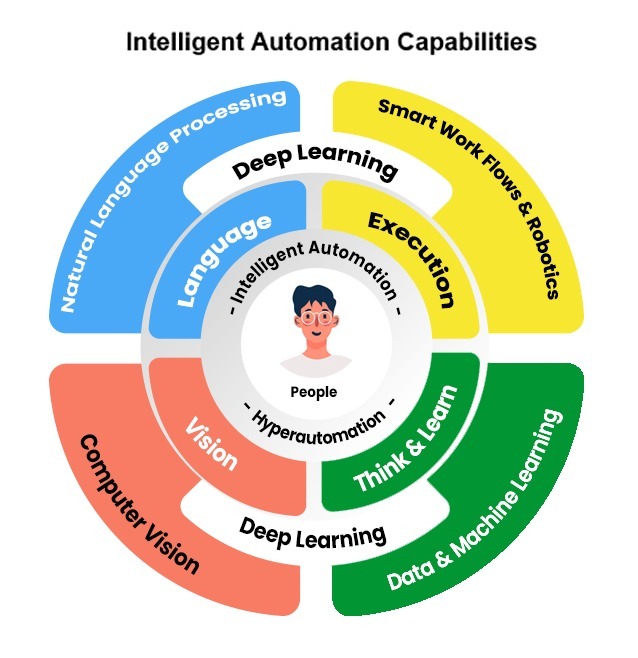
AI has made its presence felt in many aspects of our life – when shopping, even getting an Uber or talking to customer care, it’s right there, making life easier. Artificial intelligence and automation obviously then are transforming the way we work as well. While many are wary of AI taking their jobs, the truth is that automation will open up even more opportunities. Let’s deep dive into what is intelligent automation, applications of an intelligent automation platform in the workplace and potential challenges to the adoption of intelligent process automation.
What is intelligent automation?
Repetitive tasks like processing paperwork and other transactional work is not a job anyone enjoys. When the same steps have to be gone through ad infinitum, the chances of error increases. Going back to trace the error is not only frustrating but time consuming as well. Stats show that companies the world over are suffering a loss of $7 trillion because of loss in productivity.
Here is where automation steps in to free people from such laborious work while increasing accuracy. Intelligent automation combines artificial intelligence, machine learning, computer vision and robotic process automation to create automated workflows that not only think but will also learn and adapt to changes.
Also read: 7 Legacy System Modernization Approaches, Which One Works Best for Your Business?
Intelligent automation definition aside, how does it really work?
Here are the four parts of the IA anatomy that makes machines more human
Computer vision: This copies human vision in that it can make computers understand the content and context of images and videos. Using computer vision, AI workflows automate tasks that normally require human vision to achieve.
Execution: These are the smart workflows which create the automated workforce
Natural Language Processing: This is the part of automation that can understand and respond to human conversations, making it invaluable in customer service
Think and learn: Machine learning is the “brain’ of the intelligent part of the automated workforce

Intelligent automation in the workplace
Intelligent automation presents several exciting opportunities for organizations but will also bring about a fundamental shift in the way we work.
1. Restructuring organizational infrastructure
For an intelligent automation platform to be deployed successfully, organizations need to have a robust technological foundation. Automation of certain functions in some capacity, collaborative work setups and internal sharing of data are basic necessities for Intelligent Automation. Unfortunately, many large organizations, particularly those still using legacy software are not structured along these parameters. Before the introduction of automation, teams within an organization had very clear-cut responsibilities with little scope for knowledge sharing and collaboration. As a result, these teams often operate in silos and processes are highly fragmented.
Also read: How businesses use ML to improve processes
2. Streamline decision making processes
According to one report, unstructured data comprises 80 percent of all available data for a business. Combing through this data to categorize, analyze and draw insight from it can be extremely time-consuming. Additionally, manual processing of data is always prone to human error. An Intelligent Automation platform can free humans from this tedious task and deliver clearer insights to businesses in a fraction of the time it would require for humans to do it.
All humans need to do is to create a customized workflow for a specific set of data and allow the IA tool to analyze the data based on the set rules. This is one of the key benefits.
IA’s decision-making capabilities has applications in a number of industries including finance and healthcare. In health insurance, for example, IA workflows can analyze physician notes and map them to insurance policy coverage and medical best practices. In finance, IA tools can spot key parameters of credit-worthiness of an individual to determine the credit limit that should be offered to them.
3. Strengthen security and compliance
With the introduction of GDPR and other similar data security regulations, compliance has become crucial for organization. Failure to adhere to these security guidelines can lead to heavy fines and loss of credibility for an organization. When dealing with mountains of data, it can become difficult for human teams to manually identify security lapses. This can have very serious consequences for organizations.
With the introduction of Intelligent Automation, ensuring security and compliance can become a lot simpler. After compliance guidelines are entered, IA tools can cross-check existing datasets with the guidelines to identify any irregularities. IA can also play a proactive role in strengthening an organization’s cybersecurity. Through routine checks of firewalls and other security measures, IA can identify any potential weaknesses and either resolve them or alert human teams. This saves IT departments valuable time.
4. Reskilling and upskilling workers
The deployment of an Intelligent Automation platform has a lot of potential to allow humans to make more meaningful contributions to the workforce. However, for this to happen, companies need to be willing to invest in upskilling and retraining their employees. IA can take over many repetitive, process-driven tasks, but basic human attributes like empathy, innovation, and creativity cannot be replaced.
In the new age workforce, these qualities are going to be more in demand than ever before. Companies need to provide resources and workshops to help their teams hone these skills and learn how to best leverage them in their work. The end-result will not be robots displacing humans entirely, but humans and robots working together to achieve greater efficiency and productivity than ever before. Freed from having to perform non-value add tasks, humans will have greater mental resources to allocate to strategy and out-of-the-box problem solving. This can help speed up growth and profitability for organizations.
Enabling remote work during COVID-19
The use of an Intelligent Automation platform in the workforce is likely to get a push from the COVID-19 pandemic. Lockdowns across the world have forced offices to work remotely. In this new setup, most on-premise legacy software has proved to be ineffective and organizations had to migrate to cloud-based solutions. This has created the perfect technological environment for IA to be adopted by a larger number of organizations and at a faster rate. The pandemic has almost certainly irreversibly changed the way we work and IA is set to be at the forefront of the tech revolution.
Intelligent Automation presents several important benefits for organizations, but in order to reap its full potential, companies have to fundamentally rethink the way they are structured, the training that employees are given and the technology that they currently use. But despite the uncertainties, what is clear is that IA is the future of the workforce and those companies that deploy it are set to enjoy long-term gains in operational efficiency and profitability.



